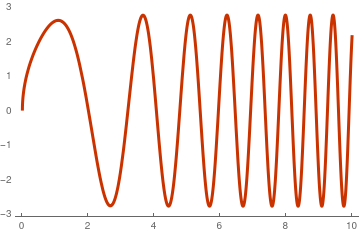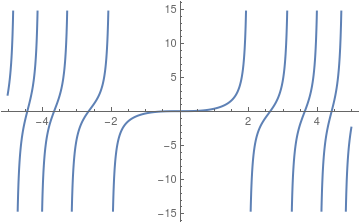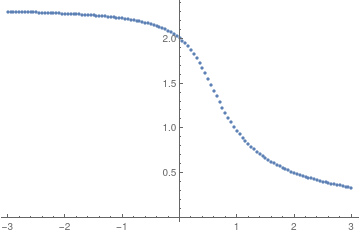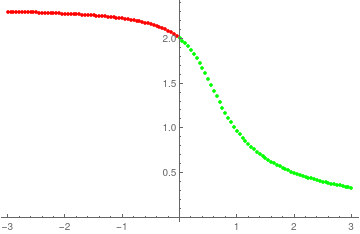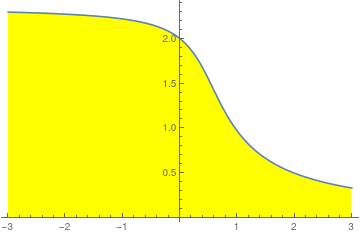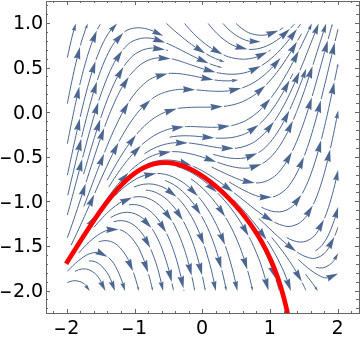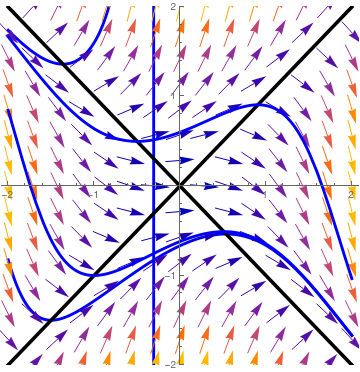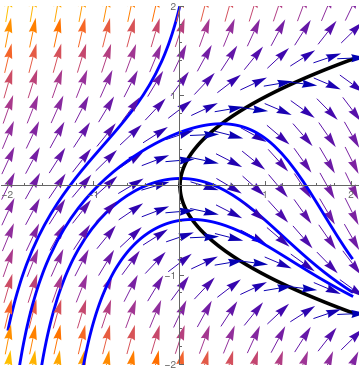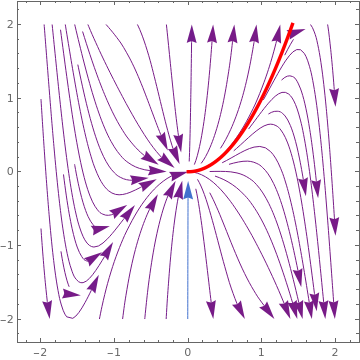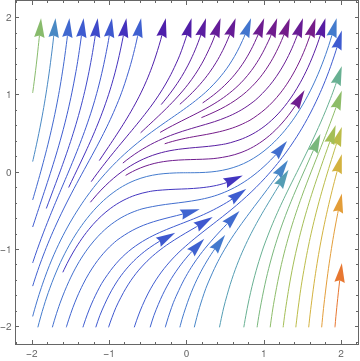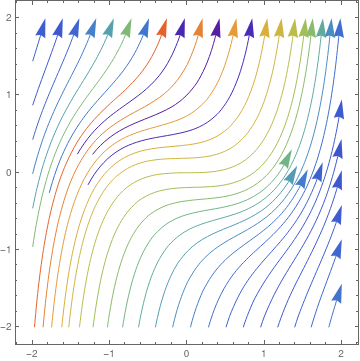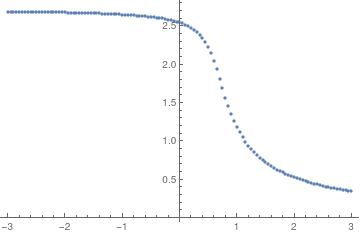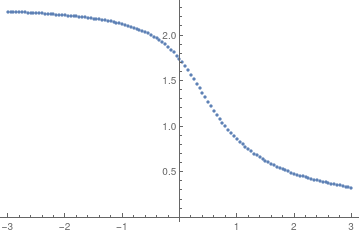\begin{equation}
y' + p(x)\,y = g(x)\,y^2 + h(x) , \label{EqRiccati.1}
\end{equation}
are some real-valued given functions. Riccati himself was concerned
with solutions to so called
\begin{equation}
y' = a\,y^2 + x^{\alpha} . \label{EqRiccati.2}
\end{equation}
to study law. He received a doctorate in law in 1696. Encouraged by Stefano degli
Angeli to pursue mathematics, he studied mathematical analysis. Riccati received various academic offers,
but declined them in order to devote his full attention to the study of mathematical analysis on his own.
. He was also
invited to
as an imperial councilor and was offered a professorship at the University of Padua.
He declined all these offers. He was often consulted by the Senate of Venice on the construction of canals and dikes along rivers.
\begin{equation}
y(x) = - \frac{u'}{g(x)\,u(x)} . \label{EqRiccati.3}
\end{equation}
Substitution of the above expression into the Riccati equation yields the second order linear differential equation for
\begin{equation*}
u'' + a(x)\, u' (x) + b(x)\, u =0, \qquad \mbox{where} \quad a(x) = p(x) - \frac{g' (x)}{g(x)} , \quad b(x) = g(x)\,h(x) . %\label{Eq.riccati.4}
\end{equation*}
Conversely, every linear homogeneous differential equation with variable coefficients
\[
u(x) = \exp \left\{ y(x)\,{\text d} x \right\} .
\]
It is sometimes possible to find a solution of a Riccati equation by guessing. Without knowing a solution to the Riccati equation, there is no chance of finding its general solution explicitly. If one solution ϕ is known, then substitution w = y - ϕ reduces the Riccati equation to a Bernoulli equation. Another substitution y = ϕ + 1/v also reduces the Riccati equation to a Bernoulli type.
\begin{equation}
u(x) = \sqrt{x}\,\begin{cases}
C_1 J_{1/2q} \left( \frac{\sqrt{ab}}{q} \, x^q \right) + C_2 Y_{1/2q} \left( \frac{\sqrt{ab}}{q} \,
x^q \right) , &
\quad \mbox{if } ab> 0, \\
C_1 I_{1/2q} \left( \frac{\sqrt{-ab}}{q} \, x^q \right) + C_2 K_{1/2q} \left( \frac{\sqrt{-ab}}{q} \,
x^q \right) , & \quad \mbox{if } ab< 0,
\end{cases} \label{EqRiccati.4}
\end{equation}
are modified Bessel functions. Note that the general solution depends on the
ratio
of two arbitrary constants. Actually,
{{y[x] -> (-a x^2 BesselJ[-(3/4), x^2/2] Gamma[1/4] +
x^2 BesselJ[-(5/4), x^2/2] Gamma[3/4] +
BesselJ[-(1/4), x^2/2] Gamma[3/4] -
x^2 BesselJ[3/4, x^2/2] Gamma[3/
4])/(x (a BesselJ[1/4, x^2/2] Gamma[1/4] -
2 BesselJ[-(1/4), x^2/2] Gamma[3/4]))}}
\begin{equation} \label{EqRiccati.5}
y(x) = x\,\frac{-a\, J_{-3/4} \left( x^2 /2 \right) \Gamma \left( \frac{1}{4} \right) + J_{-5/4} \left( x^2 /2 \right) \Gamma \left( \frac{3}{4} \right) - J_{3/4} \left( x^2 /2 \right) \Gamma \left( \frac{3}{4} \right)}{a\, J_{1/4} \left( x^2 /2 \right) \Gamma \left( \frac{1}{4} \right) - 2\,J_{-1/4} \left( x^2 /2 \right) \Gamma \left( \frac{3}{4} \right)} .
\end{equation}
\( y' = x^2 + y^2 , \quad y(0) = 0 \) is
\begin{equation} \label{EqRiccati.6}
y(x) = x\,\frac{-Y_{-3/4} \left( \frac{x^2}{2} \right) + J_{-3/4} \left( \frac{x^2}{2} \right)}{Y_{1/4} \left( \frac{x^2}{2} \right) - J_{1/4} \left( \frac{x^2}{2} \right)} = x\,\frac{J_{3/4} \left( \frac{x^2}{2} \right)}{J_{-1/4} \left( \frac{x^2}{2} \right)} .
\end{equation}
Proof:
We make transformation
y =
u r v s , which we substitute into the special Riccati equation:
\[
r\,u^{r-1} u' \,v^s + s\,u^r v^{s-1} v' = a\,u^{2r} v^{2s} + b\, x^2 .
\]
Choosing
\[
\begin{split}
r\,u^{r-1} u' \,v^s &= b\,x^2 , \\
s\,u^r v^{s-1} v' &= a\,u^{2r} v^{2s} \qquad \Longleftrightarrow \qquad s\,v' = a\, u^r v^{s+1} .
\end{split}
\]
Differentiation of the latter, we obtain
\[
s\, v'' = ar\, u^{r-1} u' \, v^{s+1} + a \left( s+1 \right) u^r v^s v' .
\]
The nonlinearity can now be removed by choosing
s = -1. Then using the latter, we get
\[
s\, v'' = ab\, u^{r-1} u' \, v^{s+1} = ab\, x^2 v \qquad\mbox{or} \qquad v'' = -ab\, x^2 v .
\]
Since the equation
\( v'' + ab\, x^2 v = 0 \) has the general solution expressed through Bessel functions (see
section )
\[
v(x) = \sqrt{x} \left[ C_1 J_{1/4} \left( \frac{\sqrt{ab}\,x^2}{2} \right) + C_2 Y_{1/4} \left( \frac{\sqrt{ab}\,x^2}{2} \right) \right] ,
\]
where
C 1 and
C 2 are arbitrary constants, we arrive at the required formula. Using
Mathematica
v[x_] = Sqrt[
x]*(k*BesselJ[1/4, alpha*x^2 /2] + BesselY[1/4, alpha*x^2 /2])
we obtain the general solution of the
special Riccati equation:
\[
y(x) = \frac{1}{2x} \,\frac{\sqrt{ab}\,k x^2 J_{3/4} \left( \frac{\sqrt{ab}\, x^2}{2} \right) + k\, J_{1/4} \left( \frac{\sqrt{ab}\, x^2}{2} \right) - \sqrt{ab} \, k x^2 J_{5/4} \left( \frac{\sqrt{ab}\, x^2}{2} \right) + \sqrt{ab}\, x^2 Y_{-3/4} \left( \frac{\sqrt{ab}\, x^2}{2} \right) + Y_{1/4} \left( \frac{\sqrt{ab}\, x^2}{2} \right) - \sqrt{ab} \,x^2 Y_{5/4} \left( \frac{\sqrt{ab}\, x^2}{2} \right) }{k\, J_{1/4} \left( \frac{\sqrt{ab}\, x^2}{2} \right) + Y_{1/4} \left( \frac{\sqrt{ab}\, x^2}{2} \right)} ,
\]
where
k is an arbitrary constant, and
ab is positive.
▣
We can find the limit of the solution to the
special Riccati equation when x → 0:
\begin{align}
\lim_{x\to 0} y(x) &= \frac{\sqrt{ab}}{8\,\Gamma^2 \left( \frac{1}{4} \right) \Gamma \left( \frac{5}{4} \right)} \left[ \sqrt{2}\, \Gamma \left( \frac{1}{4} \right) \left( \Gamma \left( -\frac{1}{4} \right) - 4\,\Gamma \left( \frac{3}{4} \right) \right) \Gamma \left( \frac{5}{4} \right) -2k\pi \left( \Gamma \left( \frac{1}{4} \right) + 4\, \Gamma \left( \frac{5}{4} \right)\right) \right] \notag
\\
&= -\frac{\sqrt{ab}}{\pi} \,\Gamma^2 \left( \frac{3}{4} \right) \left( 1+ k\right) \approx -0.477989 \left( 1 + k \right) \sqrt{ab} . \label{Eq.riccati.6}
\end{align}
Example 1: standard Riccati equation
Example 1:
\[
y' = x^2 + y^2
\tag{1.2}
\]
has the general solution
\( y= -u' /u , \) given
\[
u(x) = \sqrt{x} \left[ C_1 J_{1/4} \left( x^2 /2 \right) + C_2 Y_{1/4} \left( x^2 /2 \right) \right] ,
\]
where
C 1 and
C 2 are arbitrary constants.
The solution of the Riccati equation subject to the homogeneous initial condition
y (0) = 0 is known from Eq.\eqref{EqRiccati.6}:
\begin{equation*}
y(x) = x\,\frac{-Y_{-3/4} \left( \frac{x^2}{2} \right) + J_{-3/4} \left( \frac{x^2}{2} \right)}{Y_{1/4} \left( \frac{x^2}{2} \right) - J_{1/4} \left( \frac{x^2}{2} \right)} . %\label{Eq.riccati.7}
\end{equation*}
This solution blows up at
x ≈ 2.00315 where the denominator is zero.
sol = DSolveValue[{y'[x] == x^2 + (y[x])^2, y[0] == a}, y[x], x];
2.003147359426885
The denominator in formula \eqref{EqRiccati.6} has infinite (countable) many roots, which is seen from its plot
Plot[Evaluate[Denominator[sol /. a -> 0]], {x, 0, 10},
PlotTheme -> "Web"]
Denominator plot.
We plot a family of standard Riccati equation under different initial conditions with the following
Mathematica code:
soln = DSolve[{y'[x] == y[x]^2 + x^2, y[0] == C}, y[x], x]
0.0417911
Now we test how
Mathematica handle discontinuities (singular points) while solving the initial value problems numerically. It turns out that
NDSolve command provides a very accurate approximation of the critical point:
x0 = Last[
Reap[NDSolve[{y'[x] == x^2 + (y[x])^2, y[0] == 0}, y, {x, 0, 3},
EvaluationMonitor :> Sow[x]]][[2, 1]]] // Quiet
2.0031471284132385
which is accurate up to 7 decimal places.
Next, we plot singular points for the family of singular solutions of the initial value problems
\[
y' = x^2 + y^2 , \qquad y(0) = a .
\]
A singular point
x0 where solution blows up is plotted together with the corresponding initial condition giving a set of points on the plane: (
x0 , 𝑎).
data = {#,
Quiet[Last[
Reap[NDSolve[{y'[x] == x^2 + (y[x])^2, y[0] == #},
y, {x, 0, 10}, EvaluationMonitor :> Sow[x]]][[2, 1]]]]} & /@
Range[-3, 3, 0.05]
If # is in the 2nd place in the list {...}, the order of the list is changed.
{Quiet[Last[
Reap[NDSolve[{y'[x] == x^2 + (y[x])^2, y[0] == #}, y, {x, 0, 10},
EvaluationMonitor :> Sow[x]]][[2, 1]]]], #} & /@
Range[-3, 3, 0.05]
Solution diagram.
Solution diagram with extra #.
ListLinePlot[{#,
Quiet[Last[
Reap[NDSolve[{y'[x] == x^2 + (y[x])^2, y[0] == #},
y, {x, 0, 10}, EvaluationMonitor :> Sow[x]]][[2, 1]]]]} & /@
Range[-3, 3, 0.05], Filling -> Axis, FillingStyle -> Yellow]
Existence solution diagram.
The initial value problem
\( y' = y^2 + x^2 , \quad y(0) =0 \) has two forms of solutions \eqref{EqRiccati.6}
expressed through
Bessel functions of the first kind only:
\begin{equation*}
y(x) = x\,\frac{J_{3/4} \left( \frac{x^2}{2} \right)}{J_{-1/4} \left( \frac{x^2}{2} \right)} = x\,\frac{-Y_{-3/4} \left( \frac{x^2}{2} \right) + J_{-3/4} \left( \frac{x^2}{2} \right)}{Y_{1/4} \left( \frac{x^2}{2} \right) - J_{1/4} \left( \frac{x^2}{2} \right)}.
\end{equation*}
To convince you that this is the same solution presented in another form, we do two things. First, we expand the above solution into Maclarin series and compare it with true expansion. Second, we verify that our function satisfies the given Riccati equation and the initial condition because the solution of such initial value problem is unique.
AsymptoticDSolveValue[{y'[x] == x^2 + (y[x])^2, y[0] == 0},
y[x], {x, 0, 16}]
\[
y(x) = \frac{1}{3}\, x^3 + \frac{1}{63}\, x^7 + \frac{2}{2079}\, x^{11} + \frac{13}{218295}\,x^{15} + O\left( x^{16} \right)
\]
First, we define two solution-functions in
Mathematica :
f[x_] = x*BesselJ[3/4, x^2 /2]/BesselJ[-1/4, x^2 /2];
We check their power series:
N[Series[f[x], {x, 0, 16}]]
Then we check whether these two functions are solutions of the Riccati equation (1.2):
FullSimplify[D[f[x], x] - x^2 - (f[x])^2]
Finally, we check the initial conditions
f[0]
In order to determine where the solution blows up, we find the zero of the denominator:
FindRoot[BesselY[1/4, x^2 /2] - BesselJ[1/4, x^2 /2], {x, 2.0}]
{x -> 2.003147359426885}
FindRoot[BesselJ[-1/4, x^2 /2], {x, 2.0}]
{x -> 2.003147359426885}
Then we evaluate some numerical values:
f[x_] = x*BesselJ[3/4, x^2 /2]/BesselJ[-1/4, x^2 /2];
-2.77556*10^-17
which is numerically zero.
The solution of the Riccati equation \( y' = y^2 + x^2 \) subject to the initial condition y (0) = 1 is
\[
y(x) = x\,\frac{\left( \pi - \Gamma^2 \left( \frac{3}{4} \right) \right) J_{-3/4} \left( \frac{x^2}{2} \right) - \Gamma^2 \left( \frac{3}{4} \right) Y_{-3/4} \left( \frac{x^2}{2} \right)}{\left( \pi - \Gamma^2 \left( \frac{3}{4} \right) \right) J_{1/4} \left( \frac{x^2}{2} \right) + \Gamma^2 \left( \frac{3}{4} \right) Y_{1/4} \left( \frac{x^2}{2} \right)} .
\tag{1.2}
\]
This solution blows up at
x ≈ 0.969811 where the denominator is zero.
DSolve[{u'[x] == x^2 + (u[x])^2 , u[0] == 1}, u, x]
{x -> 0.969811}
The solution of the initial value problem
\[
y' = x^2 + y^2 , \qquad y(0) = -1 ,
\]
is
\[
y(x) = x\,\frac{\left( \pi + \Gamma^2 \left( \frac{3}{4} \right) \right) J_{-3/4} \left( \frac{x^2}{2} \right) - \Gamma^2 \left( \frac{3}{4} \right) Y_{-3/4} \left( \frac{x^2}{2} \right)}{\left( \pi + \Gamma^2 \left( \frac{3}{4} \right) \right) J_{1/4} \left( \frac{x^2}{2} \right) + \Gamma^2 \left( \frac{3}{4} \right) Y_{1/4} \left( \frac{x^2}{2} \right)} .
\tag{1.3}
\]
This solution blows up at
x ≈ 4.1785 where the denominator is zero.
DSolve[{u'[x] == x^2 + (u[x])^2 , u[0] == -1}, u, x]
{x -> 4.17851}
■
Example 2: Another standard Riccati equation
Example 2:
\[
y' = x^2 - y^2 .
\tag{2.1}
\]
Its solution
is expressed as
\( y= u' /u , \) where
\[
u(x) = \sqrt{x} \left[ C_1 I_{1/4} \left( x^2 /2 \right) + C_2 K_{1/4} \left( x^2 /2 \right) \right] ,
\]
When we impose the homogeneous conditions
y (0) = 0, then its solution becomes
\[
y(x) = x\,\frac{I_{-3/4} \left( \frac{x^2}{2} \right) \pi \sqrt{2} - 2\,K_{3/4} \left( \frac{x^2}{2} \right)}{\pi \sqrt{2}\,I_{1/4} \left( \frac{x^2}{2} \right) + 2\, K_{1/4} \left( \frac{x^2}{2} \right)} .
\tag{2.2}
\]
The initial value problem
\[
y' = x^2 - y^2 , \qquad y(0) =1 ,
\tag{2.3}
\]
has the solution
\[
y(x) = x\,\frac{\left( \pi + \Gamma^2 \left( \frac{3}{4} \right) \sqrt{2} \right) I_{-3/4} \left( \frac{x^2}{2} \right) \pi - 2\, \Gamma^2 \left( \frac{3}{4} \right) K_{3/4} \left( \frac{x^2}{2} \right)}{\left( \pi + \Gamma^2 \left( \frac{3}{4} \right) \sqrt{2} \right) I_{1/4} \left( \frac{x^2}{2} \right) \pi + 2\,\Gamma^2 \left( \frac{3}{4} \right) K_{1/4} \left( \frac{x^2}{2} \right)} .
\tag{2.4}
\]
We plot the separatrix (in red) for the Riccati equation
\( y' = x^2 - y^2 \) that separates solutions approaching +∞ from solutions that go to -∞.
sp = StreamPlot[{1, x^2 - y^2}, {x, -2, 2}, {y, -2, 1},
StreamScale -> Medium, LabelStyle -> {FontSize -> 18, Black}];
Separatrix for the Riccati equation (2.1).
Mathematica code
If we consider a similar Riccati equation
\[
y' = y^2 - x^2
\tag{2.5}
\]
its direction field is very similar. Th4e solution of Eq.(2.5) subject to the homogeneous initial condition is
\[
y = x\, \frac{I_{-3/4} \left( \frac{x^2}{2} \right) \pi\sqrt{2} - 2\, K_{3/4} \left( \frac{x^2}{2} \right)}{\pi\sqrt{2}\,I_{1/4} \left( \frac{x^2}{2} \right) + 2\, K_{1/4} \left( \frac{x^2}{2} \right)} , \qquad y(0) = 0.
\tag{2.6}
\]
However, for another initial condition, its solution becomes
\[
y = x\, \frac{I_{-3/4} \left( \frac{x^2}{2} \right) \pi \left( \sqrt{2}\,\Gamma^2 \left( \frac{3}{4} \right) + \pi \right) - 2\, K_{3/4} \left( \frac{x^2}{2} \right) \Gamma \left( \frac{3}{4} \right)}{\pi \left( \sqrt{2}\,\Gamma^2 \left( \frac{3}{4} \right) + \pi \right) I_{1/4} \left( \frac{x^2}{2} \right) + 2\, K_{1/4} \left( \frac{x^2}{2} \right) \Gamma \left( \frac{3}{4} \right)} , \qquad y(0) = 1.
\tag{2.7}
\]
We plot two nullclines (in black) for the Riccati equation
\( y' = y^2 - x^2 \) and some typical solutions.
dfield = VectorPlot[{1, y^2 - x^2}, {x, -2, 2}, {y, -2, 2},
Axes -> True, VectorScale -> {Small, Automatic, None},
AxesLabel -> {"x", "dydx=y^2 - x^2"}]
Two nullclines for the Riccati equation (2.5).
Mathematica code
■
Example 3: the Riccati equation with linear independent variable
Example 3: :
\[
y' = y^2 -x .
\tag{3.1}
\]
We plot the nullcline (in black) y ² = x and phase portrait) for the Riccati equation
\( y' = y^2 - x. \)
dfield = VectorPlot[{1, y^2 - x}, {x, -2, 2}, {y, -2, 2},
Axes -> True, VectorScale -> {Small, Automatic, None},
AxesLabel -> {"x", "dydx=y^2 - x^2"}];
The nullcline and phase portrait for the Riccati equation (3.1).
Mathematica code
■
Example 4: the Riccati equation
Example 4: :
\[
y' = 2y/x+y^2 -x^4 .
\tag{4.1}
\]
We plot the separatrix and the direction field
field = StreamPlot[{1, 2*y/x + y^2 - x^4}, {x, -2, 2}, {y, -2, 2},
StreamColorFunction -> "Rainbow", StreamPoints -> 42,
StreamScale -> {Full, All, 0.04}];
Direction field and separatrix (in red).
Mathematica code.
The given Riccati equation can be solved by substitution
\( y =x^2 +1/v(x) , \) where
y 1 =
x ² is a particular solution of the given Riccati equation.
R[x_, y_] = (y'[x] - 2 y[x]/x - y[x]^2 + x^4 )
Out[11]= x^4 - (2 y[x])/x - y[x]^2 + Derivative[1][y][x]
■
Example 5: Some modifications of standard Riccati equation
Example 5: :
\[
y' = x^2 +y^2 -xy
\tag{5.1}
\]
and
\[
y' = x^2 +y^2 +xy .
\tag{5.2}
\]
First, we plot phase portraits for these equations:
StreamPlot[{1, x^2 + y^2 - x*y}, {x, -2, 2}, {y, -2, 2},
StreamColorFunction -> "Rainbow", StreamPoints -> 42,
StreamScale -> {Full, All, 0.04}]
Phase portrait for y' = x ² + y ² −xy .
Phase portrait for y' = x ² + y ² + xy .
Next, we plot existence diagram that is formed by pairs of points (𝑎,
b ), where
x = 𝑎 is a singular point where solution to the initial value problem
\[
y' = x^2 +y^2 pm xy , \qquad y(0) = b,
\tag{5.3}
\]
blows up.
ListPlot[{#,
Quiet[Last[
Reap[NDSolve[{y'[x] == x^2 + (y[x])^2 - x*y[x], y[0] == #},
y, {x, 0, 3}, EvaluationMonitor :> Sow[x]]][[2, 1]]]]} & /@
Range[-3, 3, 0.05]]
For Eq.(5.2), we use table option:
values = Range[-3, 3, 0.05]
Existence diagram for y' = x ² + y ² −xy .
Existence diagram for y' = x ² + y ² + xy .
■
References
Haaheim, D.R. and Stein, F.M.,
Methods of Solution of the Riccati Differential Equation,
Mathematics Magazine , 1969,
Vol. 42, No. 5, pp. 233--240; https://doi.org/10.1080/0025570X.1969.11975969
Robin, W., A new Riccati equation arising in the theory of classical orthogonal polynomials, International Journal of Mathematical Education in Science and Technology , 2003,
Volume 34, 2003 - Issue 1, pp. 31--42. https://doi.org/10.1080/0020739021000018746
Return to computing page for the first course APMA0330computing page for the second course APMA0340Mathematica tutorial for the first course APMA0330Mathematica tutorial for the second course APMA0340main page for the course APMA0330 main page for the course APMA0340Part II of the course APMA0330

